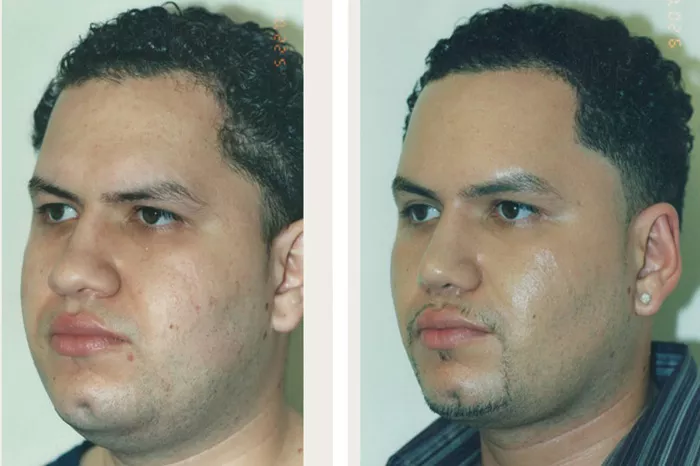Buccal fat removal has gained popularity among men seeking a more sculpted and defined facial appearance. This procedure targets the buccal fat pads, which are located in the lower cheeks. By reducing the volume of these fat pads, the face appears slimmer and more contoured. This article delves into the specifics of buccal fat removal for males, exploring its benefits, procedure, recovery, and potential risks.
Understanding Buccal Fat
What is Buccal Fat?
Buccal fat pads are pockets of fat located in the lower cheeks, situated between the facial muscles. They contribute to the fullness and roundness of the face. While buccal fat is present in everyone, its size can vary, leading to differences in facial roundness.
Why is Buccal Fat Important?
Buccal fat plays a role in the overall appearance of the face. In some individuals, it can create a youthful, full-cheeked look. However, excessive buccal fat can make the face appear rounder and less defined, which some men might find undesirable.
Reasons for Buccal Fat Removal in Men
Achieving a Chiseled Jawline
One of the primary reasons men opt for buccal fat removal is to achieve a more chiseled jawline. By removing or reducing the buccal fat pads, the contours of the cheekbones and jaw become more pronounced, giving the face a more masculine and defined appearance.
Enhancing Facial Symmetry
Buccal fat removal can also help enhance facial symmetry. Asymmetry in facial features can be due to uneven distribution of buccal fat. Removing excess fat can balance the facial proportions, leading to a more harmonious look.
Boosting Self-Confidence
A more defined facial structure can significantly boost self-confidence. Men who feel self-conscious about their round cheeks may find that buccal fat removal enhances their overall appearance, making them feel more confident in social and professional settings.
The Buccal Fat Removal Procedure
Consultation with a Surgeon
The first step in the buccal fat removal process is a consultation with a qualified plastic surgeon. During this consultation, the surgeon will assess the patient’s facial structure, discuss their goals, and determine if they are a suitable candidate for the procedure.
Preparation for Surgery
Before the surgery, patients may need to follow specific pre-operative instructions. These might include avoiding certain medications, refraining from smoking, and arranging for someone to drive them home after the procedure.
The Surgical Process
1. Anesthesia:
The procedure typically begins with the administration of local anesthesia, though some patients may opt for general anesthesia. This ensures that the patient remains comfortable and pain-free throughout the surgery.
2. Incision:
The surgeon makes small incisions inside the mouth, near the upper molars. This approach avoids visible scarring on the face.
3. Removal of Buccal Fat:
Through the incisions, the surgeon carefully removes a portion of the buccal fat pad. The amount of fat removed is tailored to achieve the desired contour while maintaining a natural appearance.
4. Closing the Incisions:
The incisions are then closed with dissolvable sutures. Since the incisions are inside the mouth, there are no visible scars.
Post-Surgery Care
1. Immediate Recovery:
After the surgery, patients are usually monitored for a short period before being allowed to go home. They may experience some swelling and discomfort, which can be managed with prescribed medications.
2. Diet and Oral Care:
Patients will need to follow a specific diet, avoiding hard and crunchy foods for a few days. Maintaining good oral hygiene is crucial to prevent infection.
3. Follow-Up Appointments:
Regular follow-up appointments with the surgeon are essential to monitor healing and ensure the desired results are achieved.
See also: How Do I Know If I Need Buccal Fat Removal?
Recovery and Results
Initial Healing Phase
The initial healing phase typically lasts about two weeks. During this time, patients may experience swelling, bruising, and mild discomfort. Following the surgeon’s post-operative care instructions is vital for a smooth recovery.
Long-Term Results
The final results of buccal fat removal become more apparent over several months as the swelling subsides. Patients can expect a slimmer, more contoured facial appearance that enhances their overall look.
Potential Risks and Complications
As with any surgical procedure, buccal fat removal carries some risks. These may include infection, asymmetry, or adverse reactions to anesthesia. However, choosing a skilled and experienced surgeon can significantly minimize these risks.
Is Buccal Fat Removal Right for You?
Ideal Candidates
Ideal candidates for buccal fat removal are men who are in good overall health, have realistic expectations, and are unhappy with the fullness of their lower cheeks. A thorough consultation with a plastic surgeon will help determine if this procedure is suitable.
Considerations and Alternatives
Men considering buccal fat removal should weigh the benefits and potential risks. Alternative options, such as facial exercises or non-surgical treatments, might also be explored. Consulting with a knowledgeable surgeon will provide clarity on the best approach.
Conclusion
Buccal fat removal offers a solution for men seeking a more defined and contoured facial appearance. By understanding the procedure, its benefits, and the recovery process, men can make informed decisions about whether this surgery aligns with their aesthetic goals. With the guidance of a skilled plastic surgeon, achieving a chiseled jawline and enhanced facial symmetry is within reach, boosting self-confidence and overall satisfaction with one’s appearance.
Related topic:
Does Insurance Cover Buccal Fat Removal?
What Is The Best Age For Buccal Fat Removal?
Is Buccal Fat Removal Covered By Insurance?

